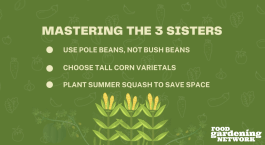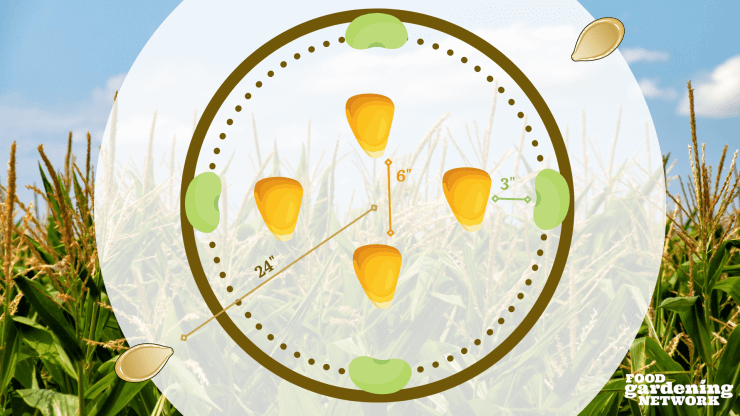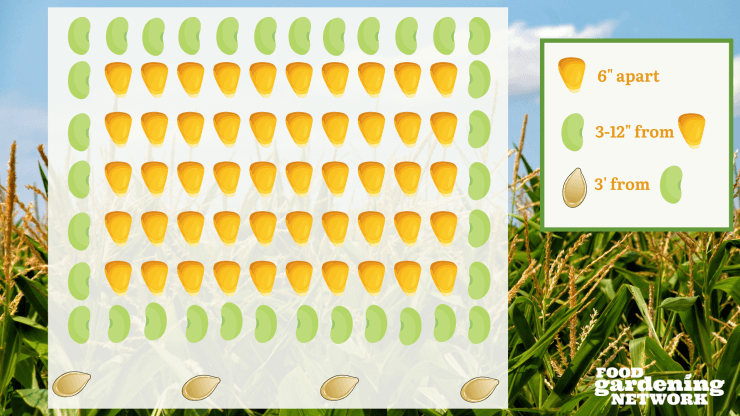
Where would wine be without cheese, or peanut butter without jelly? Simon without Garfunkel? And let’s not forget our special guests today, the “Three Sisters” otherwise known as corn, beans, and squash.
Native Americans have long understood that some plants work better together, and the Three Sisters’ planting method is based on centuries of Native American agricultural traditions. The name “Three Sisters” comes from the Haudenosaunee, also known as the Iroquois, who inhabit areas around the Great Lakes. The Haudenosaunee method includes planting the seeds of corn, beans, and squash together in the same mound. The mound is used, like it often is in planting, to prevent the roots from becoming waterlogged.
The Three Sisters garden mound has corn in the middle, pole beans around the corn, and pumpkins or other types of squash at the corners.
The height of the corn supports the bean vines; while the bean vines keep the corn stalks together for added stability.
Beans fix nitrogen in the soil; surprise — corn and pumpkins are heavy nitrogen users. This benefit can result in faster growing and more prolific corn.
The broad leaves of the pumpkin vines deter weeds and conserve moisture. And the pumpkin vines with prickly stems deter predators.
It’s a perfect “I’ve got your back” sort of planting, and the best part is that all three can either be dried or stored for the winter. The three also create a nutritional balance of carbohydrates, protein, and vitamins. Corn is high in carbohydrates, while the beans are full of protein and amino acids, and squash is rich in just about every great vitamin and mineral.
There are a few other rules to keep in mind too:
- Use pole beans, not bush beans, so they climb the corn. Runner beans and lima beans are great types to grow using this method.
- Choose tall corn varietals over shorter fast-growing ones because their stalks will be thinner and weaker.
- You can plant any type of squash, but summer squash doesn’t need as much room as pumpkins and other winter squashes if you’re short on space.
Today, farmers plant the Three Sisters in large fields to maximize yield. Traditionally, the plants were planted in mounds to drain excess water. Farmers also plant them closely together so they can grow close enough to support each other.
How to create the perfect “Three Sisters” mound
The technique for planting the Three Sisters is a bit more nuanced than just planting them in close proximity.
Generally speaking, corn wants to grow in a group, and close together, which makes this planting method make a whole lot of sense. Two things to know:
- Start with seeds and sow directly. This will create strong roots.
- Don’t plant them all at the same time. If you do, the beans will be much further along before the corn even kicks off, and the squash will be shading the plants too much for them to keep warm.
This Three Sisters planting diagram displays the most basic layout for creating traditional Three Sisters mounds in the Haudenosaunee way. Keep in mind that you want at least 25 corn plants within close proximity to one another in order for them to pollinate naturally, and ideally in a square. A 5×5 grid would be ideal, with room to walk between the mounds.

- Create mounds that are about 4 inches high with a well in the middle.
- Corn will take the longest, and the beans need it to climb, so plant corn first, ideally two to three weeks after the last frost. Plant the corn in the center of the mound, about 6 inches apart from one another.
- Wait until the corn is a few inches tall before planting beans. Plant beans about 3 inches behind the corn.
- Plant pumpkins or squash after the beans have started to climb and produce flowers. They should be planted about 24 inches from the center of the mound. Once squash starts to trail, don’t let it grow straight through the mound. Instead, train it to grow around the mound.
How to create a Three Sisters layout without mounds
Planting in mounds isn’t the only way to benefit from planting the Three Sisters. In fact, other Native American tribes have entirely different approaches to organizing these companion plants. Below is a traditional Tarahumara field.
In this Three Sisters planting diagram, a block of at least 5×5 (this diagram is more ideal at 10×5), corn is planted 6 inches apart. The corn is then surrounded by beans on every side that are planted 3 to 12 inches from the corn. On one side, to avoid issues harvesting the corn and beans on the other sides, squash is planted 3 feet from the beans.

Three other sisters
While this set of companions is clearly beneficial, I have a friend with a sensitivity to corn who instead will plant giant sunflowers and beans (or petite cucumbers), which will climb the sunflowers. Personally, the cucumbers sound like a stretch, but I like the idea. As for the vines below, you can also swap in melons.
I’ve read conflicting information about what happens to the soil around sunflowers that may hinder other plants from growing, but I haven’t personally experienced this. Have you?
What about growing the Three Sisters? Have you seen them grow together? Leave a comment below with your thoughts, and additions to these planting designs.


 Previous
Previous


Try putting coffee grounds around your corn plants. Squirrels do not like the smell of coffee. Read this somewhere. W.P.
I use drip irrigation…. how would you set up for the mound method? thanks
Brilliant idea, but my corn would not survive due to the squirrels that travel throughout my garden. I plant corn once! they were gone before fully grown.
C.R.Cowie. Canada